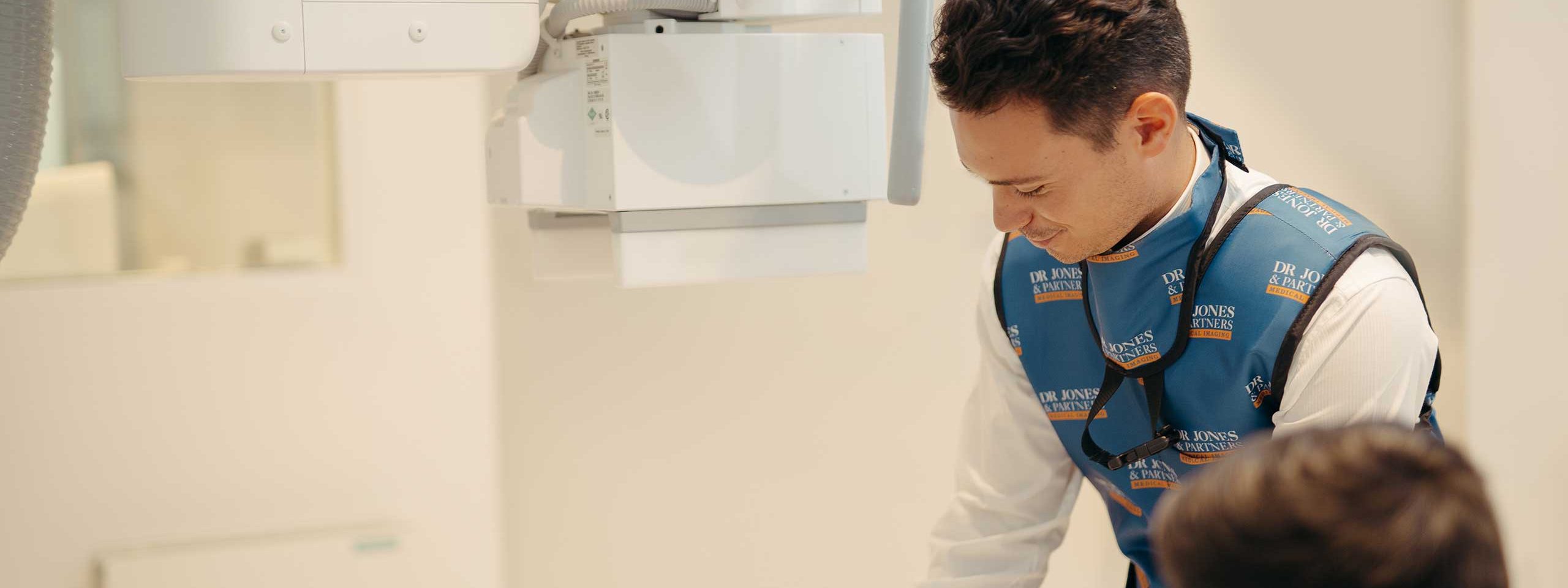Diagnostic x-rays provide information about medical conditions. X-rays have energy that penetrates deep into and through objects. An x-ray image is created when radiation passes through the body and is received on the other side by a detector. X-rays are electrically generated and are only present while the image is taken.
The x-ray energy is a type of radiation dose, and this is important to produce the images.
Depending on the density of an object, an x-ray will pass through (skin and muscle) or be absorbed (bones and metal implants). The differences in these densities are what make up an x-ray image.
Some x-ray examinations use live x-rays/fluoroscopy, which requires iodine or barium as a contrast agent (dye).
X-rays can be used to look at bones as well as other structures inside your body such as the lungs and bowel. X-rays are also used to see other things which may be inside the body such as a joint replacement, swallowed coins or other metals, or a kidney stone.
Preparation
Mostly, x-rays do not require any preparation. However, if you have a barium study, you will need to fast, which will be explained to you at the time of booking. If you have a barium enema study, you will need to collect a bowel preparation kit from one of our clinics. This kit requires you to follow a special diet and laxative drink the day before your x-ray, which will be explained to you at the time of booking, and you will be given detailed instructions.
Before your x-ray, you may be asked to change into an examination gown for your comfort and to make sure clothing does not affect the images and diagnostic quality of the x-ray. You may also be asked to remove jewellery, eye-glasses and any metal objects that might interfere with the images.
Duration
Depending on the part of the body x-rayed, you may need to stand, sit on a chair or lie down on the x-ray table. The radiographer will explain what is required and make sure you are comfortable.
The time it takes to do x-rays depends on what part of the body is x-rayed. However, they usually take between 10 and 20 minutes.
Risks / Side effects
All x-rays involve exposure to radiation. The radiation exposure from an x-ray will vary with the type of scan and the size of the patient. The x-ray beam is limited to the area being imaged to reduce the radiation dose as low as possible.
Everyone is exposed to radiation from natural sources every day. The low doses of radiation used in medical imaging mean the risk associated with exposure is so small that it can’t be reliably measured. When an x-ray is medically advised to investigate health problems or potential underlying disease, the medical benefits such as correct diagnosis and treatment, are believed to far outweigh the theoretical risks from radiation. Having an x-ray will not make you radioactive.
Pregnant women are encouraged to minimise exposure to radiation unless it is deemed necessary. It is important to tell our staff if there is any chance you may be pregnant before booking your appointment.
Patients drinking Barium for a swallow procedure may experience constipation and are advised to drink more water than normal after the procedure to ensure the bowel is flushed thoroughly.
View the Patient Care page for additional information regarding patient safety.
X-rays can be performed at our Jones Radiology clinics in Adelaide and in regional South Australia. Filter by x-ray to see all Adelaide CBD and regional clinic locations.
Are you ready to make your X-Ray appointment?
Our online booking platform allows you to quickly and easily make an appointment online.


